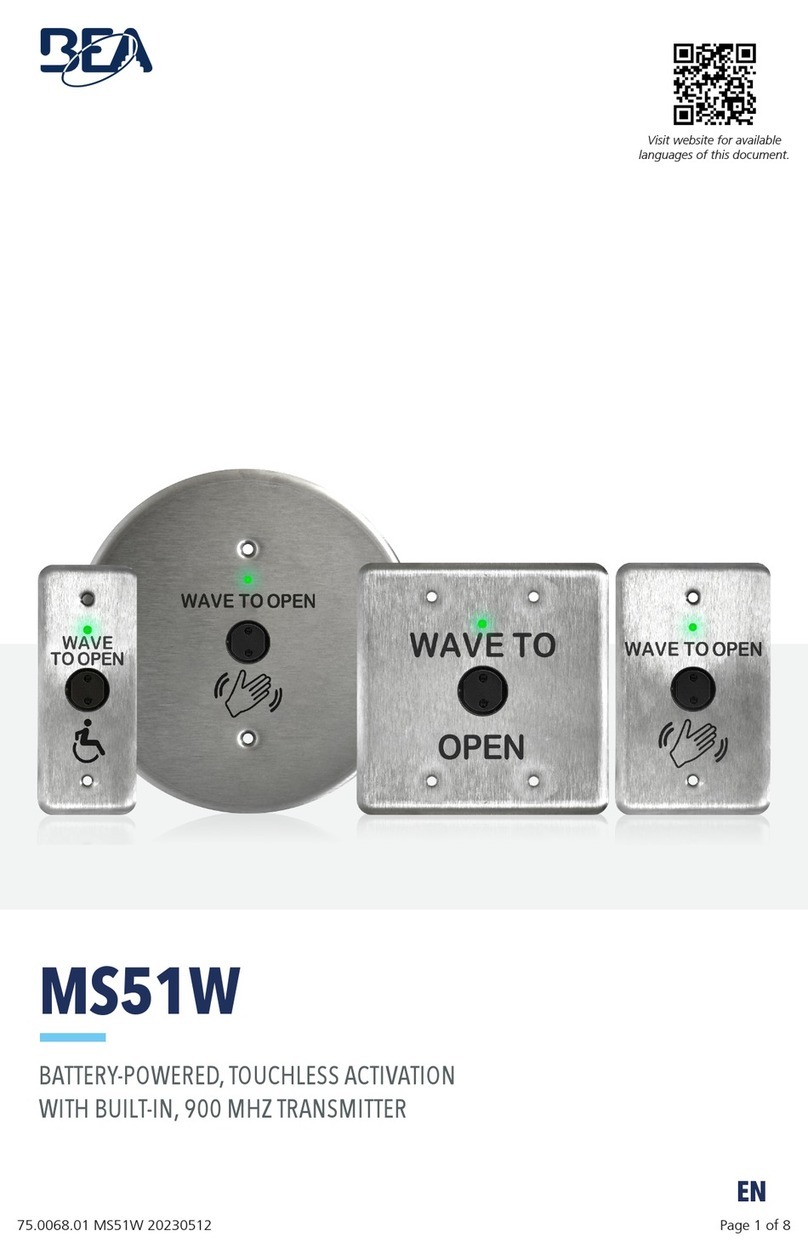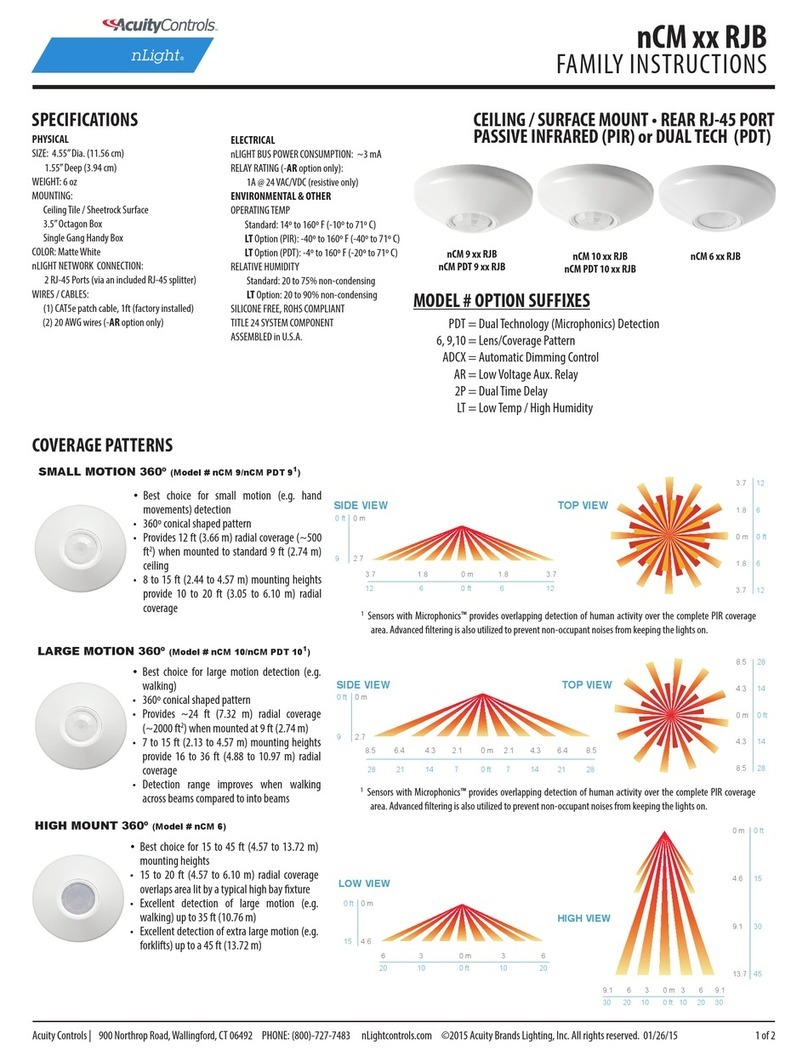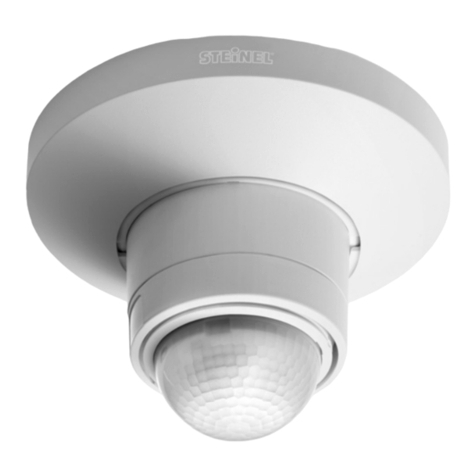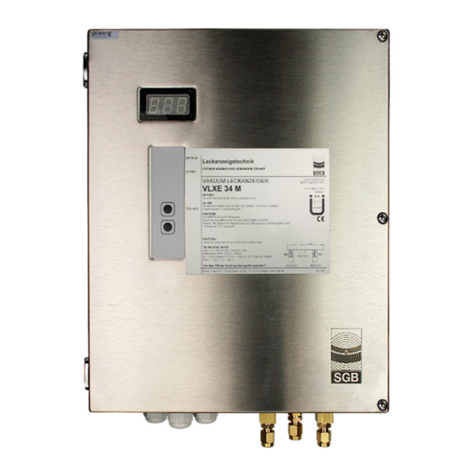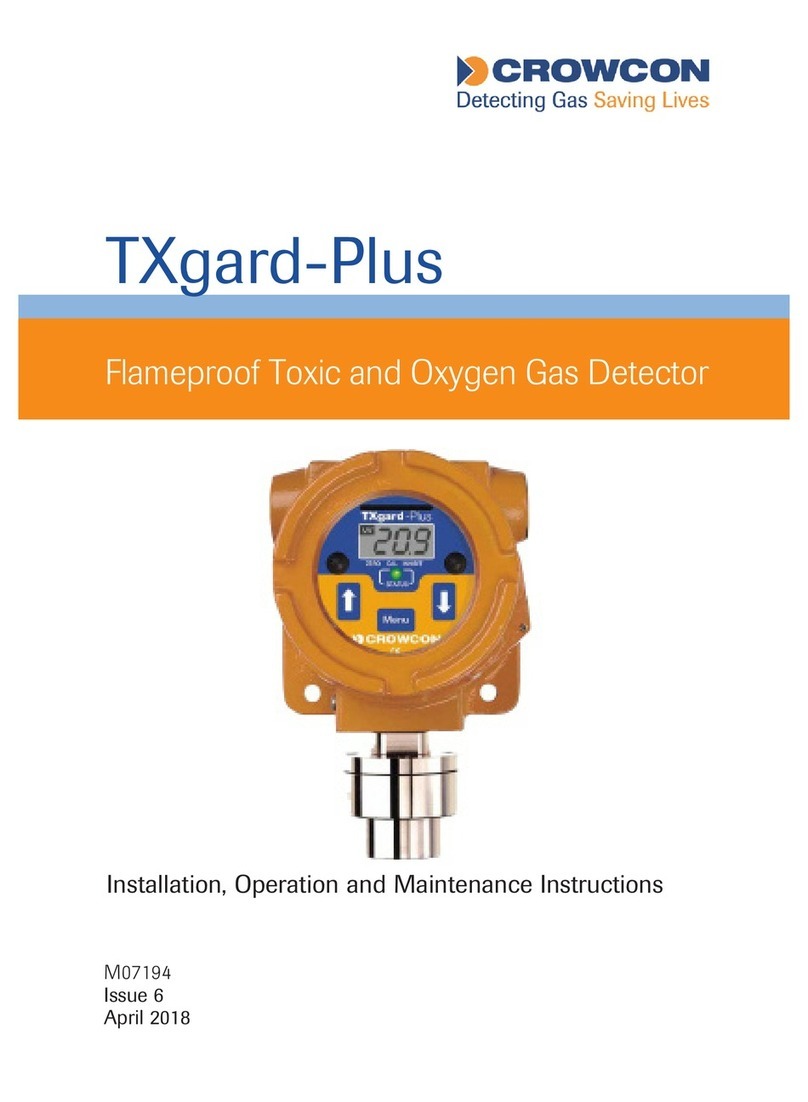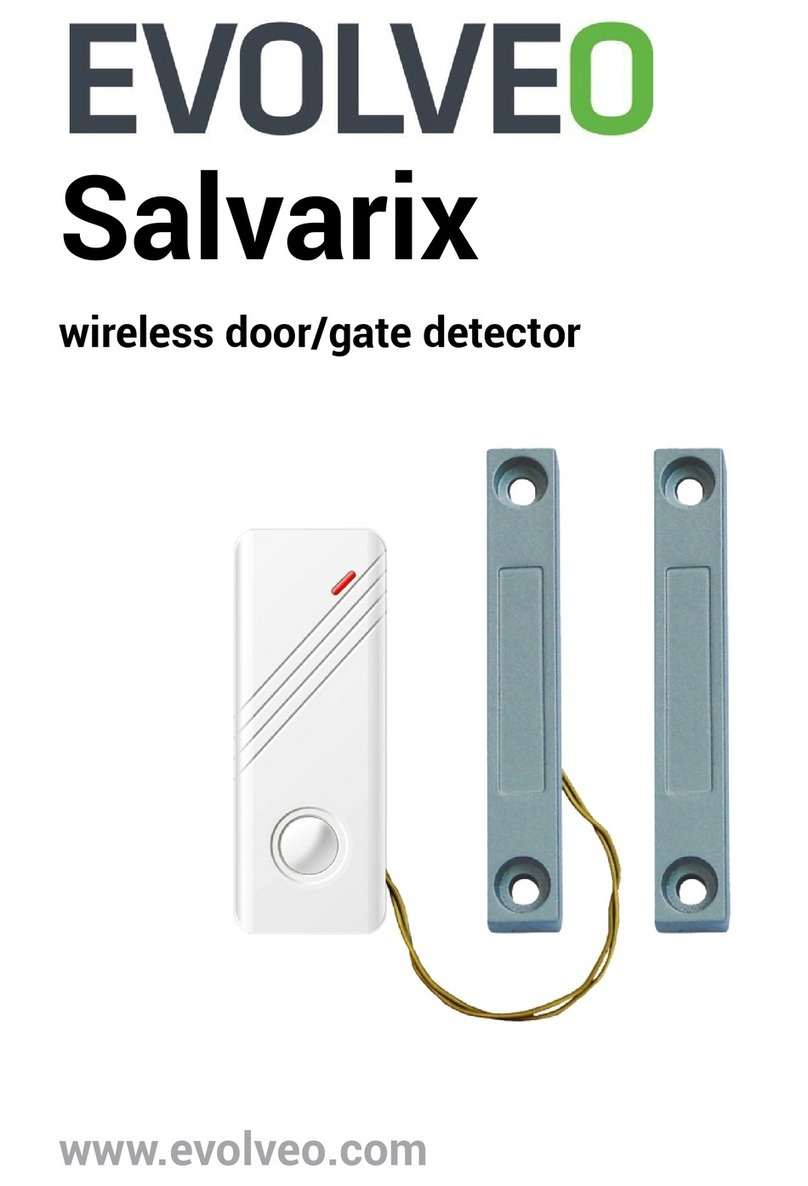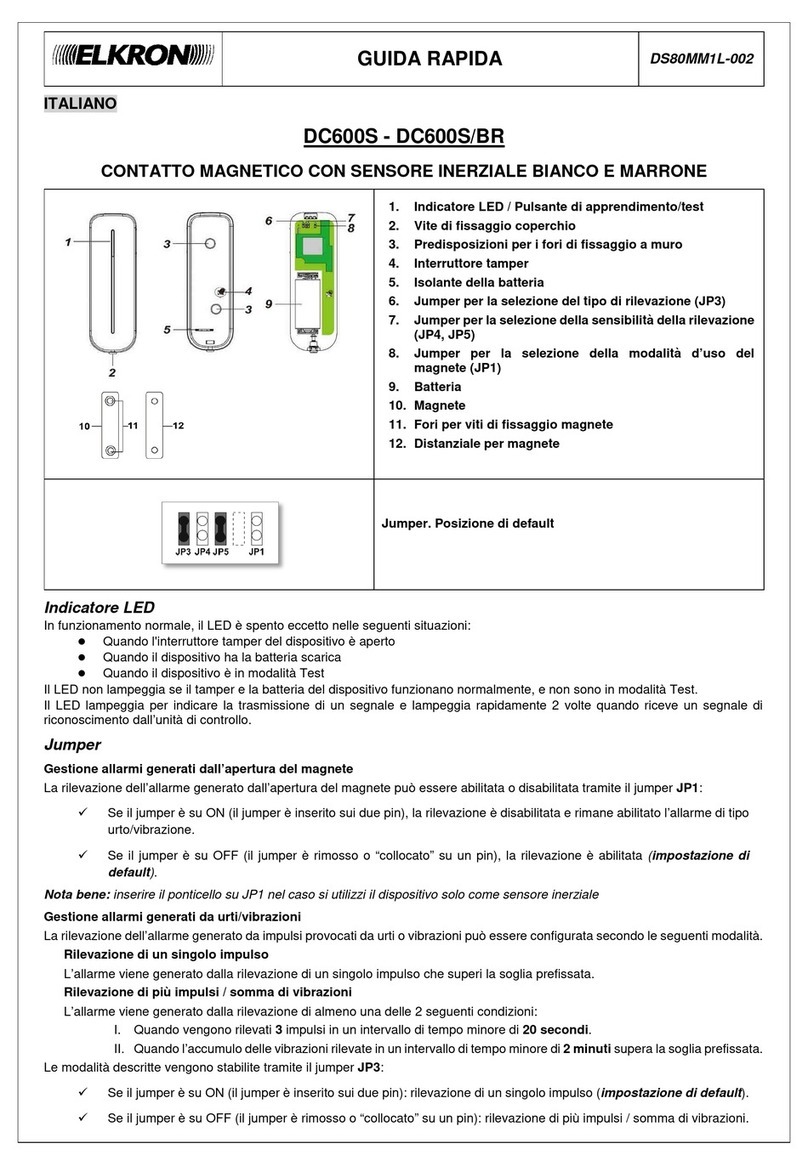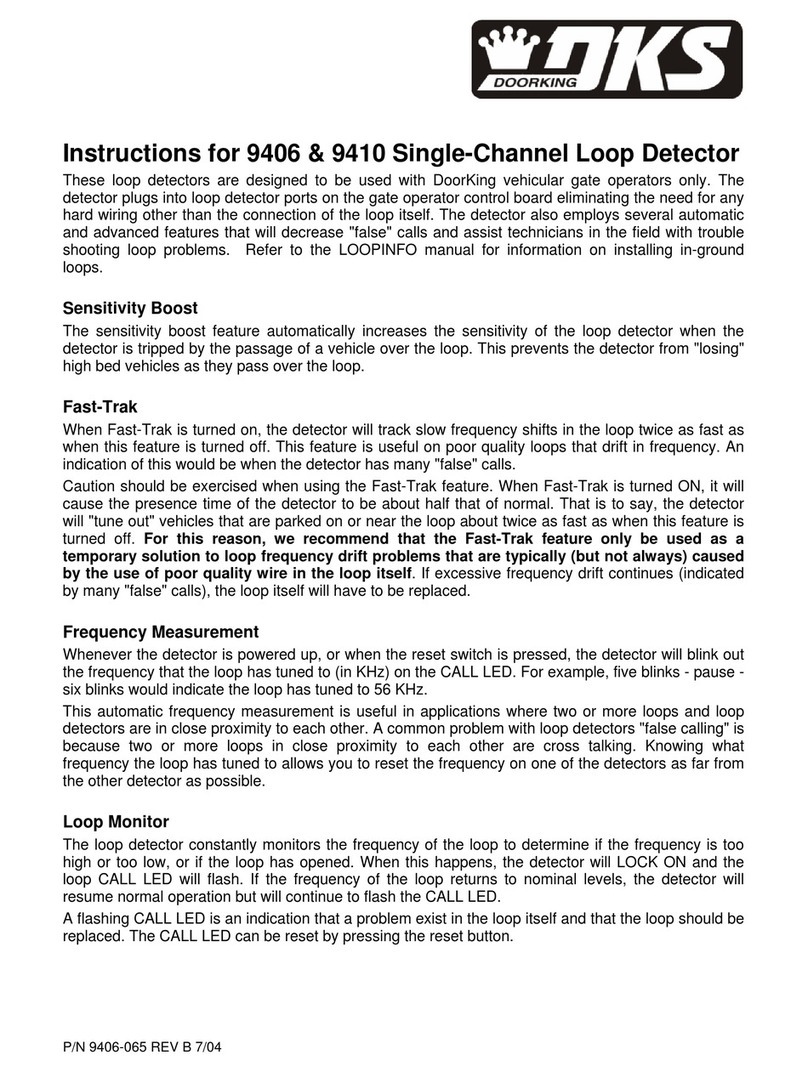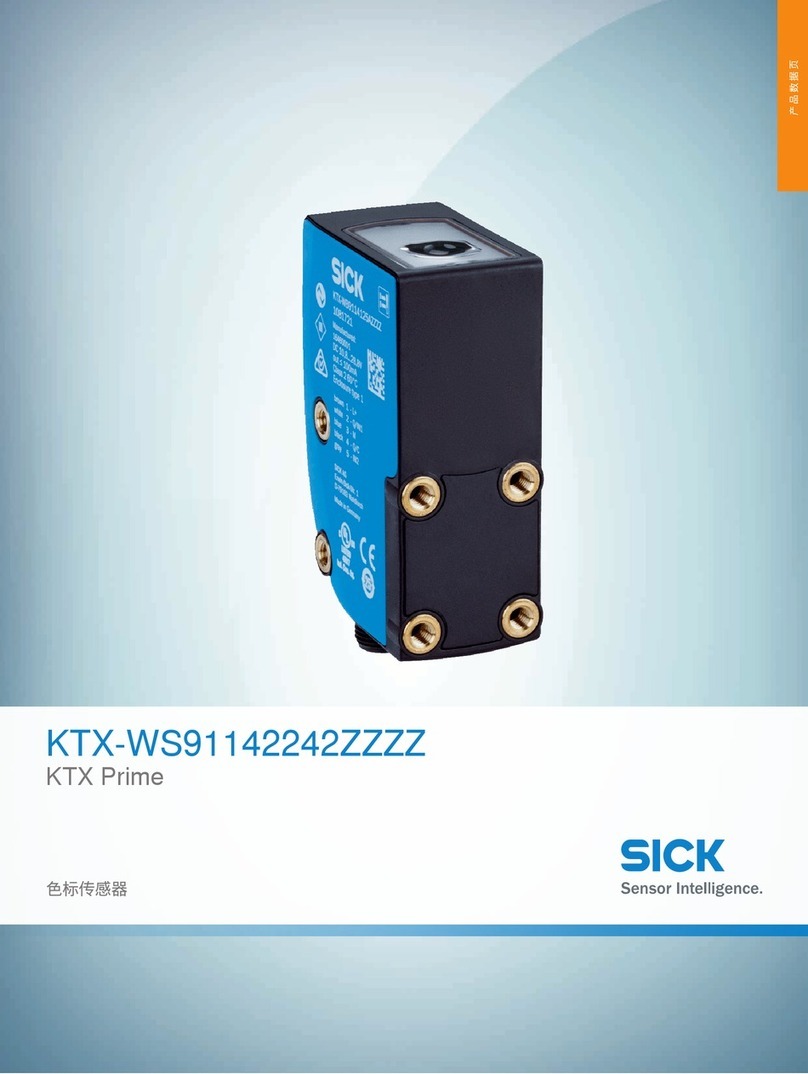mySmart MWS3A-PRM-2CH User manual

Overview
The MWS3A-PRM-2CH Microwave presence detector
provides automatic control of lighting loads with optional
manual control. It detects movement using a highly
sensitive microwave detector. This works by emitting low
power microwave signals and measuring the reflections as
the signals bounce off moving objects.
The detector provides two independently controlled output
channels that can be used for a variety of applications.
Occupancy of two independent lighting circuits using a
single detector, e.g. for essential and non-essential
supplies.
Occupancy and lux control of one lighting circuit and just
occupancy control of a second circuit, e.g. where a row of
luminaries by a windowis lux controlled whilst inner rows
are switched on occupancy only .
Occupancy and lux control of a lighting circuit and just
occupancy control of a ventilation circuit .
Occupancy on both lighting circuits, with separate lux
control on each circuit.
The unit has a unique adjustable sensor head that allows
the area of detection to be optimised for the application.
All functionality is fully programmable using an IR handset.
MWS3A-PRM-2CH Ceiling Microwave detector 2 channel
MWS3A-PRM-2CH-NC Ceiling Microwave detector 2 channel
normally closed Features
Back features
Ceiling Microwave presence/absence detector 2 channel
MWS3A-PRM-2CH,
MWS3A-PRM-2CH-NC Product Guide
Microwave Sensor
Detects movement within the unit’s detection range,
allowing load control in response to changes in occupancy.
IR Receiver
Receives control and programming commands from an
IR (infrared) handset.
Light Level Sensor
Measures the overall light level in the detection area
Status LEDs
The LED flashes Red to indicate the following:
Channel 1 Connector
Live input and output for Channel 1. Switch input
connection that can be used to manually override the lights
on or off.
Channel 2 Connector
Live input and output for Channel 2. Common Neutral
connection.
Walk Test LED active when movement is detected
Valid setting received
Retaining Spring
Retaining Spring
Channel 1
Connector
Channel 2
Connector
Front features
Sensor Lens
which covers...
Microwave Sensor
IR Receiver
Light Level Sensor
Status LEDs
Mounting Bezel

2
Detection diagram
Detection Mode
The Detection Mode can be set to behave in Presence or Absence mode:
Presence When movement is detected the load will automatically turn on. When the area is no longer occupied the
load will automatically switch off after an adjustable time period.
Absence The load is manually switched on. When the area is no longer occupied the load will automatically switch
off after the adjustable time period has elapsed.
In either case, sensitivity to movement of the Microwave sensor can be adjusted using the Sensitivity parameter.
HINT: To assist in setting the Sensitivity, turn on the Walk Test LED which will flash red when movement is detected.
Switch Level On/Off
Occupancy detection can be made dependant on the ambient light level using the Lux On Level and Lux Off Level
parameters.
The level can be set independently for each channel (UNLCDHS only). For example Channel 1 turns on with
occupancy whereas Channel 2 is held off by Lux.
Normally closed option
The MWS3A-PRM-2CH-NC provides a normally closed contact for fail safe operation. If the unit fails, the outputs will
default to on.
Sensor functionality
Ideal for large office or classroom Ideal for corridor or aisle applications
Ideal for open plan areas and offices
Note. If the range is compromised by the ceiling construction /
material. Add the supplied 20mm spacer ring. See page 4 for
fitting details.

3
Installation
To use absence detection a retractive (momentary) switch must be connected between the 2 terminals on the
diagrams. Note that this will be switching mains voltage.
The unit ships with presence detection as default. To change to absence detection, press and release the
external switch 5 times within the first minute of power up. The LED will turn on solid for 30 seconds to indicate
absence mode has been selected.
To change back to presence detection, repeat the above procedure—the LED will flash for 30 seconds to indicate
presence mode has been selected.
Note: the above adjustments can also be made using the UHS5 or UNLCDHS handsets. See Programming sections.
When power is applied to the unit, the load will turn on immediately.
Set the timeout to 10 seconds, vacate the room or remain very still and wait for the load to switch off .
Check that the load switches on when movement is detected.
The unit is now ready for programming.
Power-up test procedure
Choosing a Suitable Location
The detector should be sited so that the occupants of the room fall inside the detection pattern shown opposite).
Avoid positioning the unit where direct sunlight may enter the sensor element.
Do not site the sensor within 1m of any lighting, forced air heating or ventilation.
Do not fix the sensor to an unstable or vibrating surface.
Avoid metallic objects directly in front of the sensor head.
Note 1. When controlling two circuits, the circuits must be on the same phase.
2. L/In Ch1 is used to supply the detector with power.
CH1 and CH2 plugs are coded.
Ensure that the plugs are
inserted correctly and do not
apply excessive force
Wiring Diagram
Absence detection
The UNLCDHS has the ability to read back the settings stored in a device.
To read back individual parameters
Navigate to the parameter and press the ‘R’ (Read) button whilst pointing at the device. The handset will click
when the parameter has been read back, the device will flash its LED, and the value will be shown against the
parameter in the menu.
To read back all of the parameters in a menu
Press and hold the ‘R’ (Read) button for more than 1 second.
The handset will click every time a parameter is received
The device will show multiple flashes of its LED
All of the values will be shown against the parameters in the menu.
The individual parameters may be edited and then saved as a ‘Macro’.
Notes
If a parameter(s) has been missed because of a communication error, the missing value(s) is replaced by dashes.
When reading back, the relay will temporarily be switched off, and will return to it’s normal state 2 seconds after
the read back has been completed.
Readback function (UNLCDHS handset only)

4
The MWS3A-PRM-2CH is designed to be mounted using either:
Flush fixing, or
Surface fixing, using the optional Surface Mounting Box (part no. MWS3A-DBB).
Both methods are illustrated below.
Warning - be careful bending springs when mounting unit.
Installation
Important
Ensure that the cables are formed as shown
before affixing the cable clamp. The clamp
MUST clamp the outer sheath(s) only.
Bend cores as shown.
Wire stripping details
Flush fixing
Surface fixing
Head locking
1 32 4
Hole Ø30mm
MAX
1 2
Remove metal
locking clip from
rear of unit.
Adjust head to
required position.
Push clip into position
shown below to lock
head.
To remove clip, lever
out with a small
screwdriver.
1 543
Hole Ø74mm Attach cable clamp
2
If the range is compromised by the
ceiling construction / material. Add the
supplied 20mm spacer ring.

5
Basic programming
Parameter
Name Default
Value 0123UHS5 Handset Graphics Description
Button Activation
On On Turn lights on.
Off Off Turn lights off.
Walk test Off On Off When set to On this causes a red LED to flash on
the sensor when it detects movement. Use this
feature to check for adequate sensitivity levels.
Time Out
(Time
adjustment)
20 mins 1, 10 &
20
minutes
5, 15 &
30
minutes
10
seconds Once the detector is turned on, this value sets
how long the lights will stay on once movement
has ceased.
Lux on
level *
(Switch
level on)
9 2, 5 & 7 4, 6 & 9 Lux level setting to prevent the luminaires being
switched on if the ambient light level is sufficient
(adjustable between 1 and 9). The luminaires will
always be switched on at level 9.
Lux off
level *
(Switch
level off)
9 2, 5 & 7 4, 6 & 9 Lux level setting to switch the luminaires off during
occupancy if the ambient light level goes above
the setting (adjustable between 1 and 9). Level 9
will always keep the lights on. This setting can be
used for “window row switching”.
Note: the Lux Off Level value must always be
greater than the Lux On Level value.
Sensitivity 9 1, 5 & 9 3, 6 & 8 Sensitivity level for detecting movement.
1 = low sensitivity
9 = high sensitivity
Defaults D Returns the unit to the default settings.
Presence /
Absence * Presence Presence Absence Presence mode allows the output to turn on when
movement is detected and off when movement
ceases. Absence mode allows the output to turn
off when movement ceases, but must be manually
turned on first.
Shift Use this button to select the settings in red and
blue signified by the ‘Shift 1’ and ‘Shift 2’ LEDs
Number of Shift key presses
The functionality of the MWS3A-PRM-2CH is controlled by a number of parameters which
can be changed or programmed by any of the following devices:
UHS5 Infrared Handset. See below for programmable functions.
UNLCDHS Infrared Handset (with LCD). See user guide for full programming details.
For most basic programming operations the UHS5 handset can be used and the following procedures
are based on using this device.
Point the handset at the Sensor and send the required programming commands to the unit as shown
below.
Valid commands will be indicated by a red LED flash. See page 1 for details of other LED responses.
Note 1. Other functions on the UHS5 which are not shown below are not applicable to this product.
2. Parameters marked with an asterisk will applied be to both channels. If separate settings are
required use the UNLCDHS.
SHIFT 1 SHIFT 2 SHIFT 1 SHIFT 2SHIFT 1 SHIFT 2SHIFT 1 SHIFT 2
What if the load does not turn ON?
Check that the live supply to the circuit is good.
Check that the load is functioning by bypassing the sensor (e.g. link terminals Land L/ Out on Channel1).
If the detection range is smaller than expected, check the diagram on page 2. Adjusting the angle of the sensor head
slightly may improve the detection range. If still reduced it may be compromised by the ceiling construction /
material. Add the supplied 20mm spacer ring. See page 4 for fitting details.
HINT: The Walk Test LED function can be used to check that the unit is detecting movement in the required area.
What if the load does not turn OFF?
Ensure that the area is left unoccupied for longer than the Time Out Period.
Ensure that the sensor is not adjacent to circulating air, heaters or lamps.
Fault finding

6
Advanced programming
Parameter Name Default Value Range / Options Description UHS5 UNLCDHS
Detector Parameters
Walk Test LED Off On or Off When set to On this causes a red LED to flash on the sensor when it detects
movement. Use this feature to check for adequate sensitivity levels.
Time Out
(Time adjustment) 20 minutes 0-99 minutes Once the detector is turned on, this value sets how long the lights will stay on once
movement has ceased. Select 0 for 10 second delay –use for commissioning only.
Manual Time Out 10 minutes 0-99 minutes When a manual operation occurs, either via the switch input or the infrared, it
invokes the timeout period.
Example 1: a detector in presence mode has a detector timeout of 15 minutes and
a manual timeout of 3 minutes. When the user leaves the room they press the off
button. The sensor will revert to automatic after 3 minutes, and then walking back
in the room will turn the lights on.
Example 2: using the settings above, the user turns the lights off (say for a
presentation) but stays in the room. Every time a movement is detected, the
manual timeout period is re-triggered, but when it doesn’t pick up for the short
timeout period, the sensor will timeout and revert to automatic. This means the
lights may turn on inadvertently during the presentation, if the occupants are still
for the manual timeout period, so adjust the timing carefully.
Sensitivity On 9 1 (min) to 9 (max) Sensitivity level for detecting movement when the detector is already on. *UHS5
sets Sensitivity On and Off to the same value. *
Sensitivity Off 9 1 (min) to 9 (max) Sensitivity level for detecting movement when the detector is off. *UHS5 sets
Sensitivity On and Off to the same value. *
Lux time 0 0 (disabled)
1-99 minutes If the detector measures the lux level and decides that the output needs switching
on or off as a consequence, the lux time must elapse first. If at any time during the
timed delay the lux change reverses then the process is cancelled. Lux Time
enables absence detection to be implemented with a lux off level set. When the
button is pressed, the lights will go on, regardless of ambient light level. However,
if there is sufficient ambient light, they will turn off again after the Lux Time. Note
that whenever the an external switch is pressed, whether in absence or presence
mode, if the lights were out because of the lux level, they will be immediately
turned on again for at least the Lux Time.
Power Up State On On or Off Select No for a 30 second delay on start up. If Yes is selected, there will be no
delay on start up and the detector will always power up detecting.
On Delay 0 minutes 0-99 minutes The On Delay to allows the first channel to switch on after the second channel. A
typical application for this would be where a detector is controlling lighting and air
conditioning in an area. When the occupant is detected, the lighting will be turned
on immediately, whereas the air conditioning may be turned on after 15 minutes. If
the area is vacated and the detector times out before the delay, then the air
conditioning would never go on. The delay can be set only for channel 1 using the
on delay parameter.
Inhibit 4 seconds 1 to 999 seconds When the detector turns off, a delay is instigated to prevent retriggering. In certain
circumstances this delay may not be enough. This parameter allows the delay to
be changed.
Factory default - - Restores factory default settings
User Modes
Override On - - If the lights are off, sending the IR command will turn them on immediately and
revert to automatic operation using the manual timeout period .
Override Off - - If the lights are on, sending the IR command will turn them off immediately. After
the manual timeout period (described above), the sensor will revert to automatic.
Cancel - - Cancels the on or off override, returning the detector to normal operation.
Switching functions
To set Channel 1 functions - go to “Ch1(sw) Set “ menu on the handset
To set Channel 2 functions - go to “Ch2(dim) Set “ menu on the handset
Detection Mode Presence Presence or
Absence Presence mode allows the output to turn on when movement is detected and off
when movement ceases. Absence mode allows the output to turn off when
movement ceases, but must be manually turned on first.
Lux on level
(Switch level on) 9 1 to 9
For a higher
resolution a scale
of 101-199 is
available
Sets a minimum light level below which the Microwave sensor is enabled, allowing
lights to be turned on by movement.
Note: the Lux Level Off value must always be greater than the Lux Level On value.
Lux off level
(Switch level off) 9 1 to 9
For a higher
resolution a scale
of 101-199 is
available
Sets a maximum light level above which the Microwave sensor is disabled,
preventing lights from being turned on by movement.

7
Advanced programming
Switch Input Modes
1 position switch
together Default Short press on
Long press off A single position retractive switch controls both channels together.
1 position switch
separate - Short press on
Long press off Two single position retractive switches, controlling the channels separately.
This option can only be used in conjunction with a VITM4-2CH Vitesse
Modular marshalling box.
2 position switch
together - Short press on
Short press off A single position retractive switch controls both channels together.
2 position switch
separate - Short press on
Short press off Two single position retractive switches, controlling the channels separately.
This option can only be used in conjunction with a VITM4-2CH Vitesse
Modular marshalling box.

8
Technical data
Part numbers
Ref: #WD614 Issue 2
MWS3A-PRM-2CH
Part number Description
Detector MWS3A-PRM-2CH Ceiling Microwave presence/absence detector 2 channel
MWS3A-PRM-2CH-NC Ceiling Microwave presence/absence Detector 2 channel normally closed
Accessories MWS3A-DBB Surface mounting box
UHS5 Programming IR handset
UNLCDHS Universal LCD IR handset
Dimensions See diagrams opposite
Weight 0.15kg
Supply Voltage 230VAC +/- 10%
Both circuits must on the same
phase.
Frequency 50Hz
Maximum Load 6A of lighting and or ventilation per
channel including incandescent,
fluorescent, compact fluorescent,
low voltage (switch primary of
transformer).
Power consumption MWS3A-PRM-2CH
On 1590mW, Off 896mW
MWS3A-PRM-2CH-NC
On 1900mW, Off 893mW
Terminal Capacity 2.5mm2
Temperature -10ºC to 35ºC
Humidity 5 to 95% non-condensing
Material (casing) Flame retardant ABS and PC/ABS
Type Class 2
Safety The microwave radiation emitted by these
units is extremely low power and complies
with ANSI standard “IEEEC95.1-1999
Standard for Safety Levels with Respect to
Human Exposure to Radio Frequency
Electromagnetic Fields 3kHz 300GHz.”
IP rating IP40
Compliance EMC-2004/108/EC
LVD-2006/95/EC
MWS3A-DBB
The allowable frequency of operation of this product is different depending on region. Please select the correct order
code using the table below.
Suffix Region Frequency
blank UK, China, India, Middle East, Malaysia, Hong Kong, Singapore 10.587GHz
-R2 Australia and all of Europe except: UK, France, Portugal, Germany, Switzerland, Austria, Slovak Republic, Republic of Ireland 10.525GHz
-R3 France, Portugal, Switzerland 9.900GHz
-R4 Germany, Austria, Slovak Republic 9.350GHz
-R5 Republic of Ireland 10.41GHz
Microwave frequency compatibility
Due to our policy of continual product improvement mySmart reserves the right to alter the specification of this product without prior notice.
Unit 16
1 Talavera Road
Macquarie Park, NSW 2112
Australia
T: 1300 697 627
F: (02) 9887 1333
www.mysmart.com.au
IMPORTANT NOTICE!
This device should be installed by a qualified
electrician inaccordance with the latest edition
of the AS/NZS Wiring Rules and any applicable
Building Regulations.
This manual suits for next models
1
Table of contents
Other mySmart Security Sensor manuals
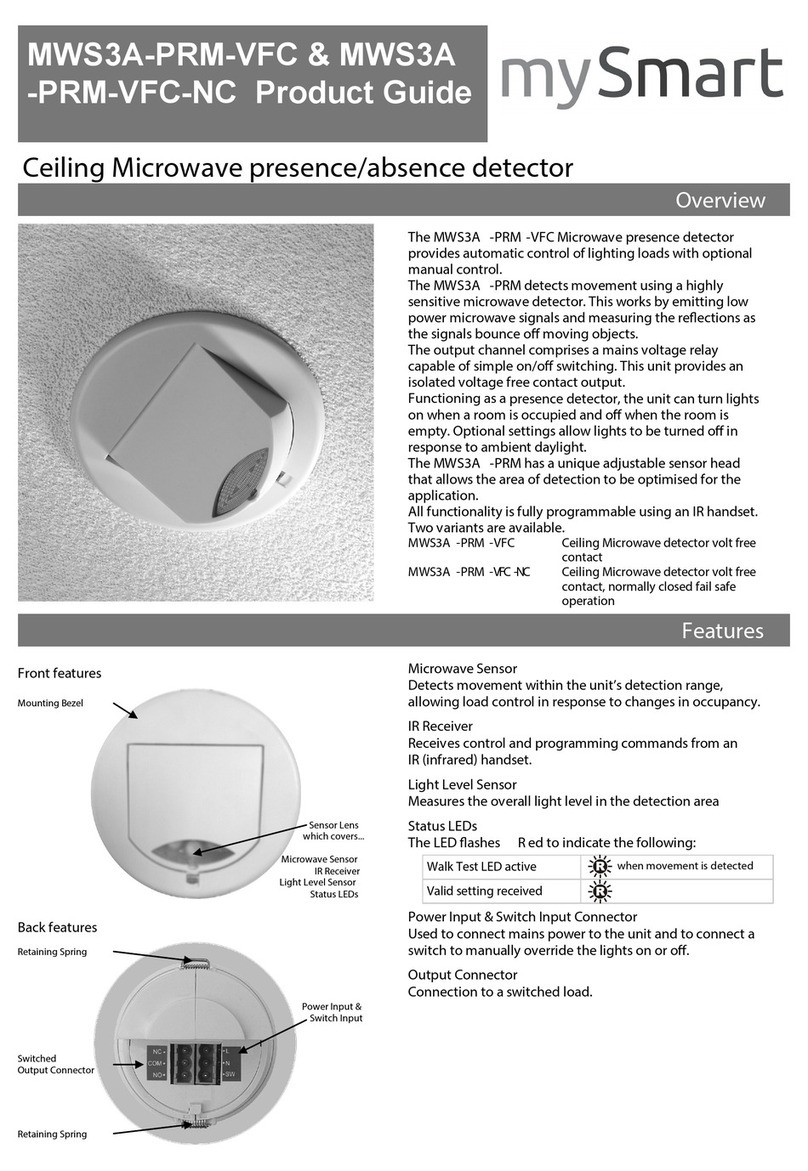
mySmart
mySmart MWS3A-PRM-VFC & MWS3A-PRM-VFC-NC User manual
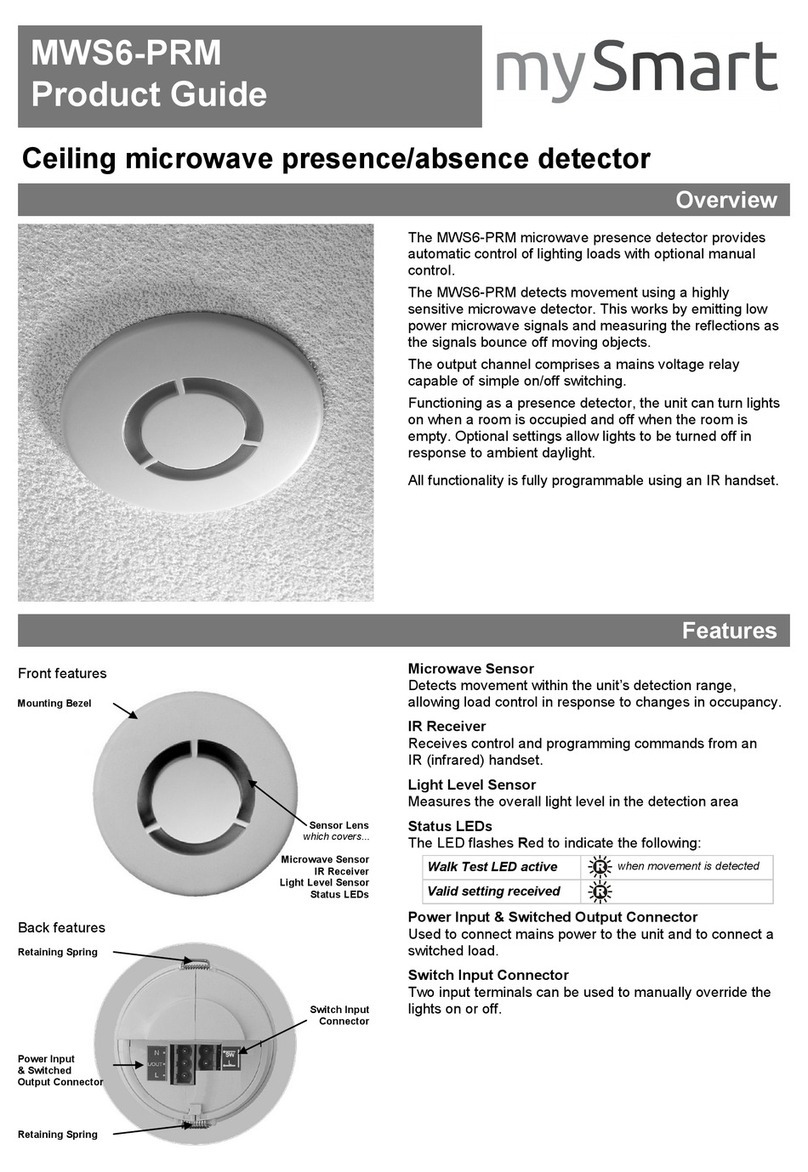
mySmart
mySmart MWS6-PRM User manual
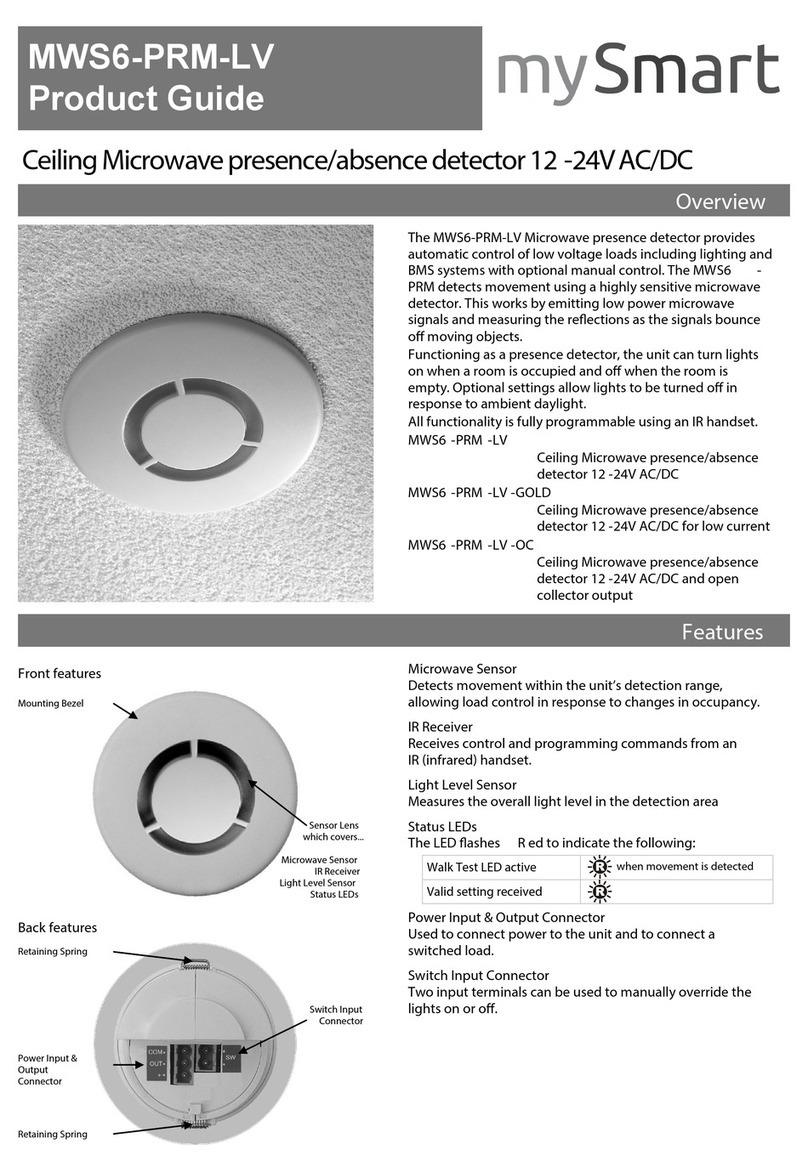
mySmart
mySmart MWS6-PRM-LV User manual
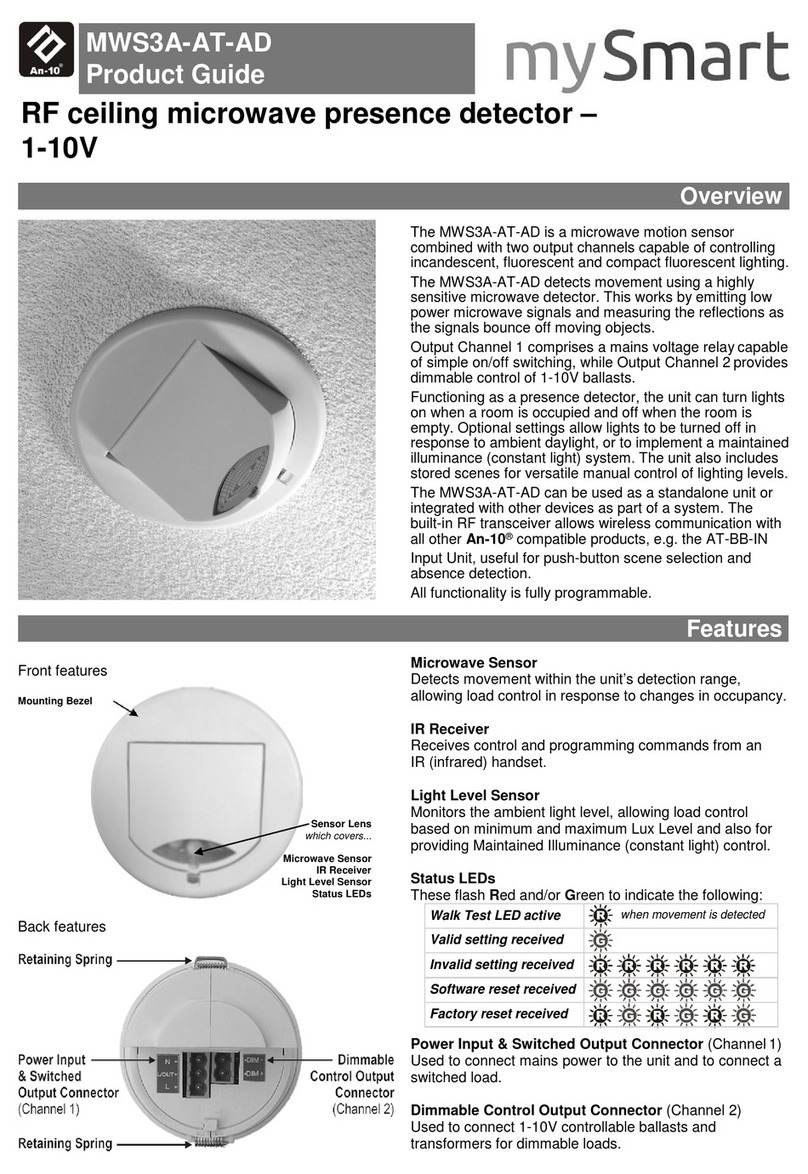
mySmart
mySmart MWS3A-AT-AD User manual
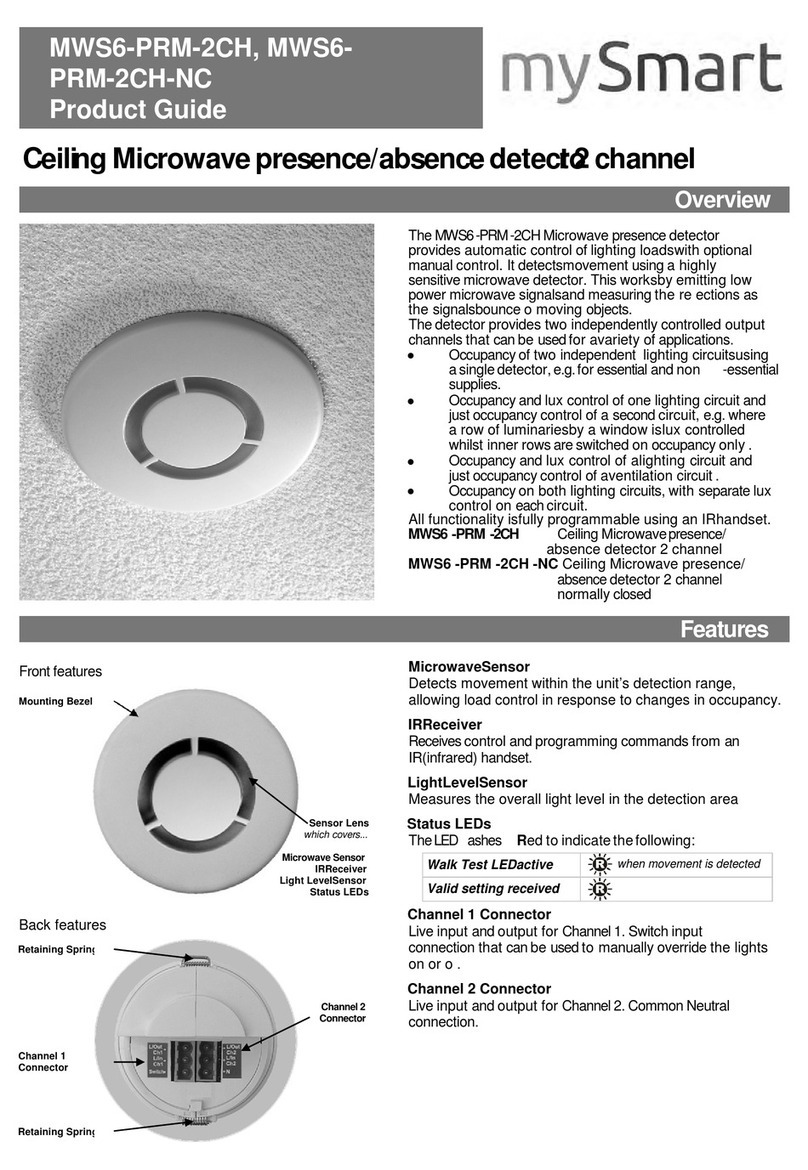
mySmart
mySmart MWS6-PRM-2CH User manual
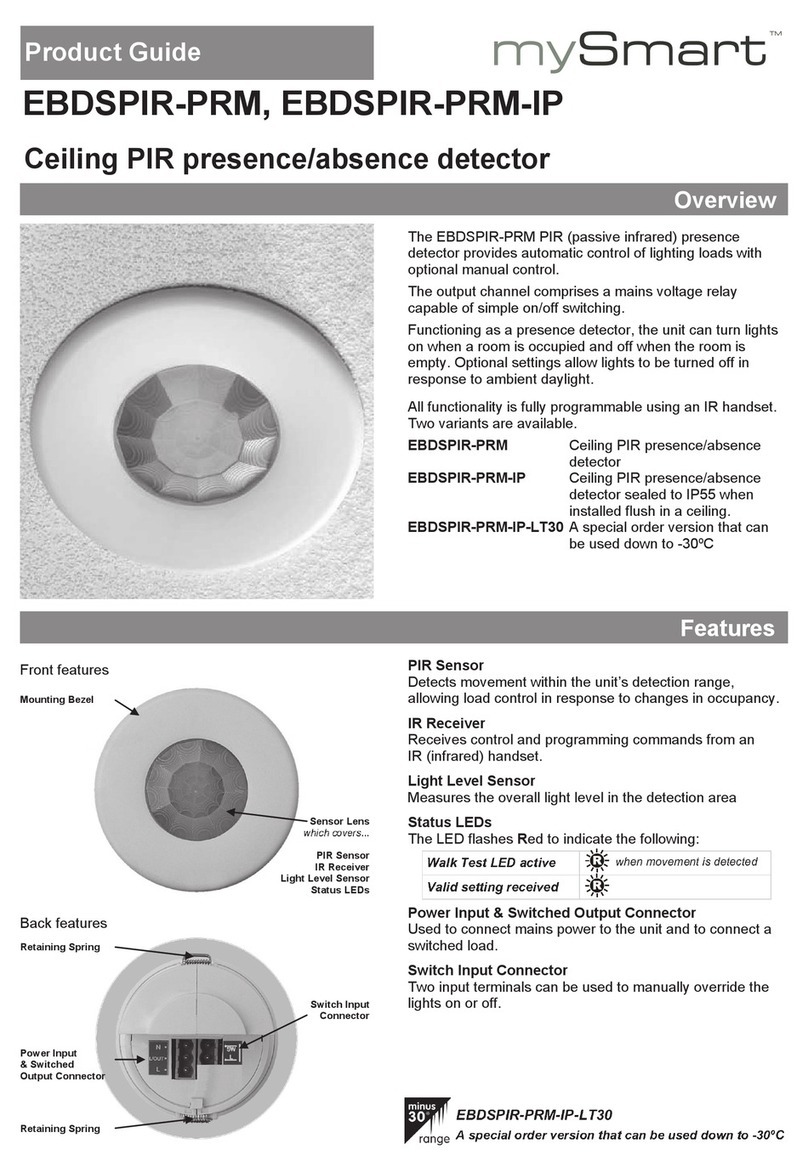
mySmart
mySmart EBDSPIR-PRM-IP User manual
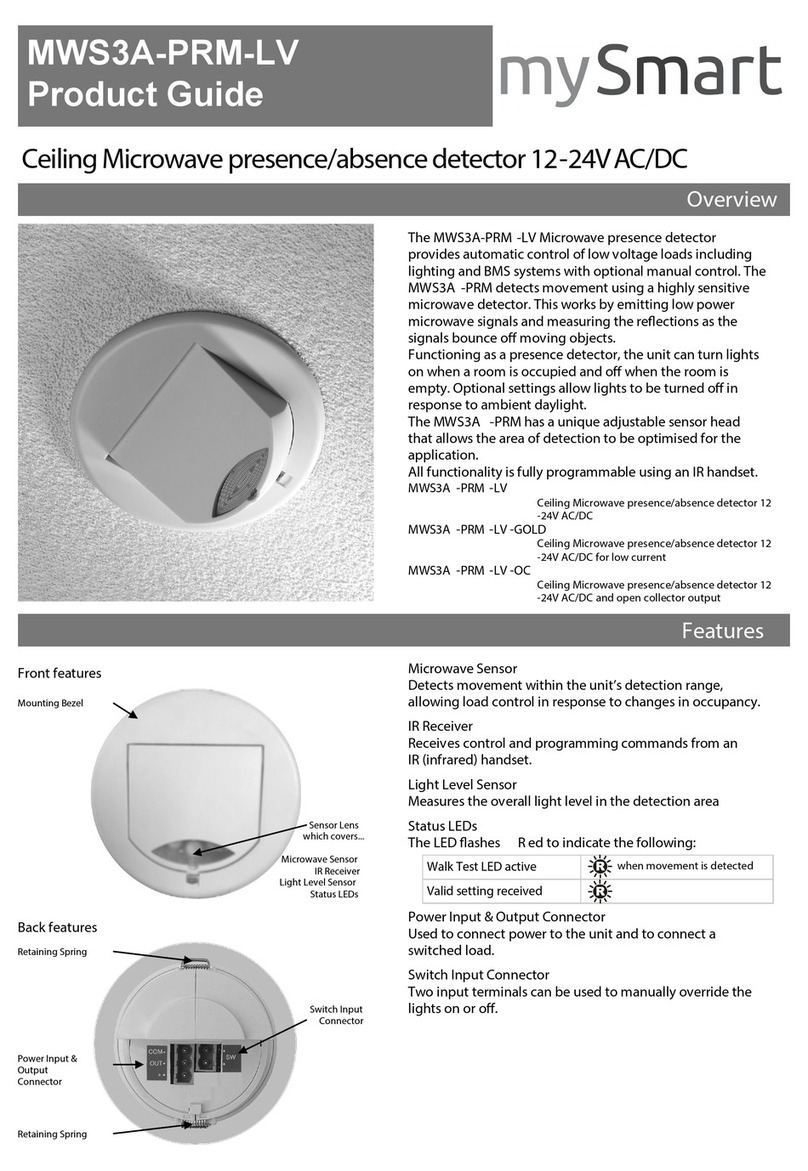
mySmart
mySmart MWS3A-PRM-LV User manual
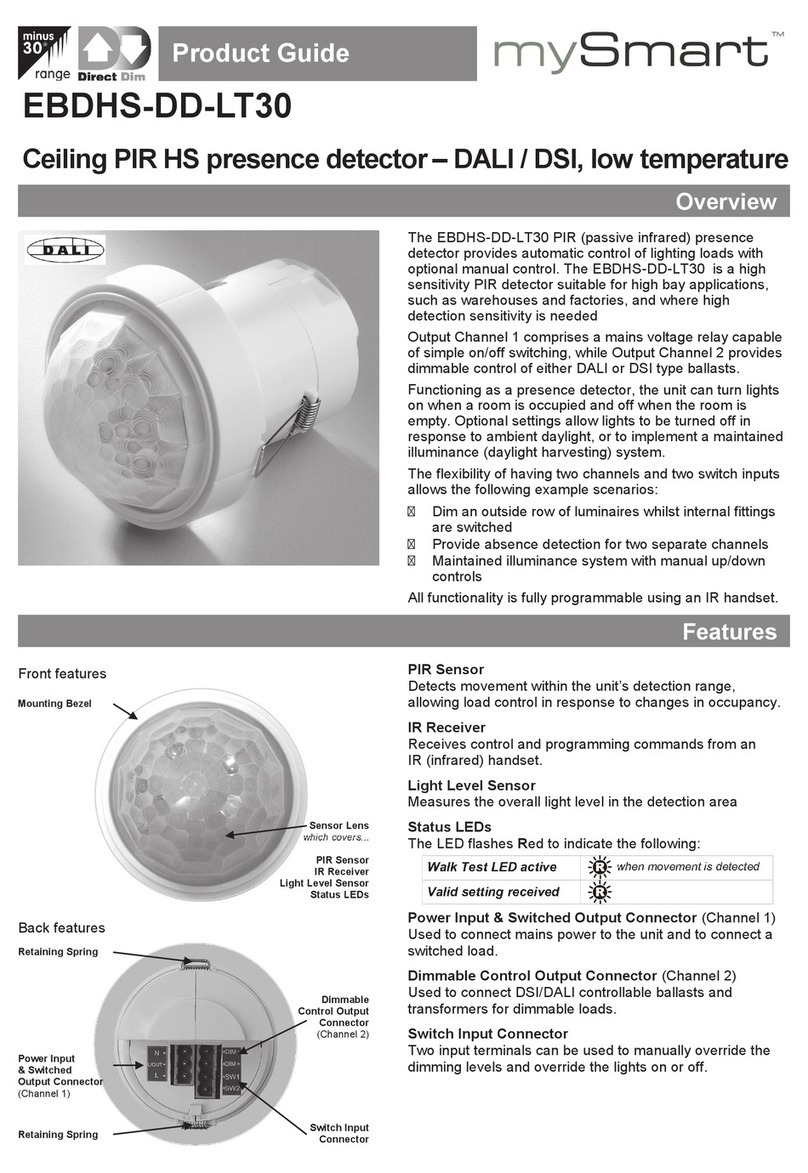
mySmart
mySmart EBDHS-DD-LT30 User manual

mySmart
mySmart MWS7 User manual
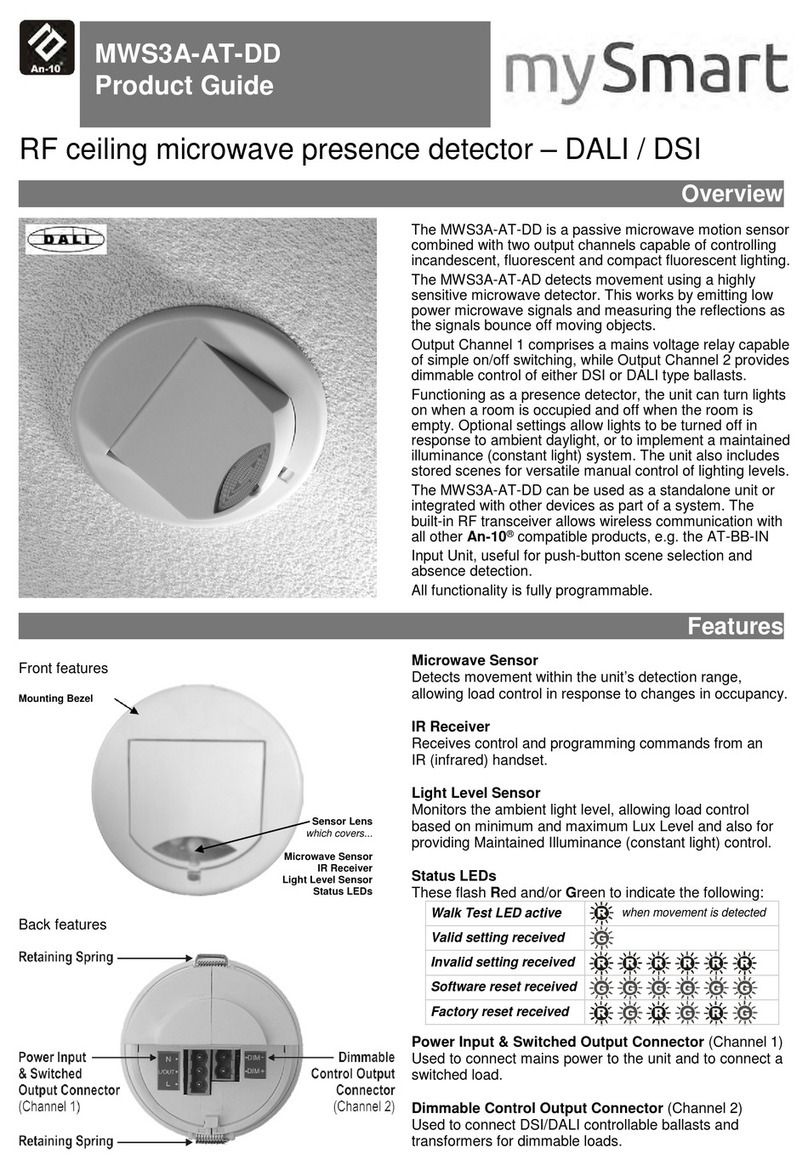
mySmart
mySmart MWS3A-AT-DD User manual

